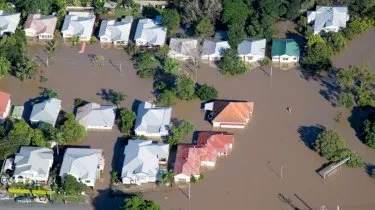Invest
Climate disasters leave 1 in 25 properties uninsurable by 2030
Climate change-induced disasters and mounting risks of dangerous weather will make one in 25 Australian properties “effectively uninsurable” by 2030, according to a damning new report from Australia’s leading climate advocacy organisation.
Climate disasters leave 1 in 25 properties uninsurable by 2030
Climate change-induced disasters and mounting risks of dangerous weather will make one in 25 Australian properties “effectively uninsurable” by 2030, according to a damning new report from Australia’s leading climate advocacy organisation.

It’s a staggering new figure released in a detailed analysis by the Climate Council titled Uninsurable Nation, in which risk assessment was allocated to federal electorates, finding that 3.6 per cent of properties totalling 520,944, would be uninsurable by 2030.
The number climbs to an even more alarming figure within Australia’s top 10 electorates most at risk of climate change impacts, rising to one-in-seven homes.
Additionally, 9 per cent of properties will reach the ‘medium risk’ classification by 2030, with annual average damage costs equalling 0.2 per cent or more of the property replacement cost.
As the threat of floods, bushfires and cyclones are becoming a more widely expected part of Australian life, those who calculate the risks and returns of insurance have come under pressure to rethink the numbers that form the odds on how to price insurance premiums or even their availability to disaster-stricken households.

But insurers and their customers caught in the dilemma have been bestowed a new online tool to assess where their properties and assets stand in the face of potential climate change disasters, in the form of the Climate Council’s Climate Risk Map, in which hundreds of millions of data points were analysed by Climate Valuation.
Australians can use the map to view how their suburb, local government area or electorate will potentially fare in the risk of fires, floods and extreme wind, based on low, medium and high emissions scenarios, reaching as far as the year 2100.
Climate Council member and leading economist and former partner at Deloitte Access Economics, Nicki Hutley said it’s clear that Australia is fast becoming an uninsurable nation.
“Skyrocketing costs or flat-out insurance ineligibility are becoming more and more widespread under climate change,” Ms Hutley said.
“As an economist, I find these new numbers shocking and deeply concerning,” she said.
Climate Valuation chief executive officer, Dr Karl Mallon said the impacts of climate hazards on 14 million Australian addresses were analysed to inform the national map showing the physical risk extreme weather and climate change poses to homes around the country over the next decade.
“It’s striking how the number of affected properties grows under higher emissions scenarios. Reducing emissions would potentially save thousands of homes from worsening damage. I encourage all homeowners and buyers to ensure they fully understand the local hazards and get a property-specific report on their risk,” Dr Mallon said.
“Insurers and banks are already quantifying the risks from climate change. It’s essential that Australians inform themselves about these risks to their safety and financial wellbeing, which are well known to financial institutions and governments.”
The stormy backdrop for insurers couldn’t be any bleaker, as the risks from the east coast’s recent floods from a persistent deluge this year have been revealed to be Australia’s costliest ever.
Using actual claims costs from 197,000 claims across NSW and Queensland, the Insurance Council of Australia (ICA) estimated floods that impacted South-East Queensland and coastal NSW in February and March cost $3.35 billion in insured losses.
According to the ICA, the rise in claims costs compared to previous floods is being driven by higher costs in the personal property, personal contents and commercial property classes reflecting the increased cost of materials and a challenging supply chain environment.
More than 11 per cent of claims have already been closed and $580 million has already been paid to policyholders, the ICA said.
As a result, the ICA has called on Australian governments to implement a range of measures to mitigate disasters, which would better protect households and communities from the impacts of extreme weather, including the doubling of federal funding of $200 million a year over five years, matched by the states and territories.
The Climate Risk Map can be viewed here. The report, Uninsurable Nation, can be viewed here.

Insurance
Australians prioritise life insurance over luxuries amid cost-of-living pressures
Australians are choosing to maintain life insurance and income protection policies over discretionary spending including gym memberships, holidays and mobile phone upgrades, new research has found. Read more

Insurance
Aussie property owners teeter on financial ruin as underinsurance crisis escalates
According to industry-first data compiled by leading insurance expert MCG Quantity Surveyors, Australian property owners are facing a dire underinsurance crisis, with many just one insurance event ...Read more

Insurance
Insurers ramp up concerns over greenwashing amid stricter ESG standards
A recent global study has shed light on the growing apprehensions within the insurance industry regarding greenwashing, as environmental, social, and governance (ESG) criteria become more rigorous. Read more

Insurance
Ortec Finance study highlights insurers' readiness to tackle increased investment risks amidst growing concerns
A new study conducted by Ortec Finance, a premier provider of risk and return management solutions for the financial sector, indicates a notable shift in the risk-taking attitude among insurers ...Read more

Insurance
Insurers running for cover from accusation of “failing consumers”
As insurance providers have recently been inundated with a large volume of claims for damages from yet another set of so-called “once-in-a-hundred-years” floods, the embattled sector is now coming ...Read more

Insurance
Class action over add-on insurance commences in court
Allianz has been accused of engaging in misleading or deceptive conduct. Read more

Insurance
Saving money on insurance means asking the right questions
There are plenty of must-do’s and missteps that those looking to buy home and contents insurance need to stay on top of. Read more

Insurance
CBA pleads guilty to criminal charges for mis-selling consumer credit insurance
Commonwealth Bank (CBA) has pleaded guilty to 30 criminal charges of making false or misleading representations to 165 customers when selling consumer credit insurance (CCI). Read more

Insurance
Australians prioritise life insurance over luxuries amid cost-of-living pressures
Australians are choosing to maintain life insurance and income protection policies over discretionary spending including gym memberships, holidays and mobile phone upgrades, new research has found. Read more

Insurance
Aussie property owners teeter on financial ruin as underinsurance crisis escalates
According to industry-first data compiled by leading insurance expert MCG Quantity Surveyors, Australian property owners are facing a dire underinsurance crisis, with many just one insurance event ...Read more

Insurance
Insurers ramp up concerns over greenwashing amid stricter ESG standards
A recent global study has shed light on the growing apprehensions within the insurance industry regarding greenwashing, as environmental, social, and governance (ESG) criteria become more rigorous. Read more

Insurance
Ortec Finance study highlights insurers' readiness to tackle increased investment risks amidst growing concerns
A new study conducted by Ortec Finance, a premier provider of risk and return management solutions for the financial sector, indicates a notable shift in the risk-taking attitude among insurers ...Read more

Insurance
Insurers running for cover from accusation of “failing consumers”
As insurance providers have recently been inundated with a large volume of claims for damages from yet another set of so-called “once-in-a-hundred-years” floods, the embattled sector is now coming ...Read more

Insurance
Class action over add-on insurance commences in court
Allianz has been accused of engaging in misleading or deceptive conduct. Read more

Insurance
Saving money on insurance means asking the right questions
There are plenty of must-do’s and missteps that those looking to buy home and contents insurance need to stay on top of. Read more

Insurance
CBA pleads guilty to criminal charges for mis-selling consumer credit insurance
Commonwealth Bank (CBA) has pleaded guilty to 30 criminal charges of making false or misleading representations to 165 customers when selling consumer credit insurance (CCI). Read more








